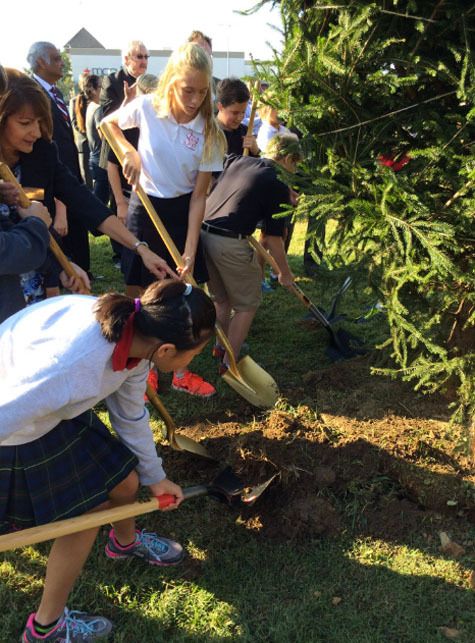
Green for good project at St. Margaret Mary Elementary School / LouisvilleKY.com
A new research report from the Nature Conservancy argues that for just $8 per person, the U.S. could maintain and then significantly expand the tree canopy of American cities, an incredibly cost-effective investment in public health.
While high-profile urban tree planting campaigns like New York City’s get a lot of attention, most U.S. cities have experienced a decline in their urban forests, with a loss of about 4 million trees each year, or about “1.3 percent of the total tree stock.” The Nature Conservancy builds the case for recommitting to expanding our urban canopies for health reasons, instead of just letting them slowly diminish.
The many benefits of trees are well-documented: they clean and cool the air, combat the urban heat island effect, capture stormwater, mitigate the risk of floods, boost water quality, and, importantly, improve our mental and physical health and well-being.
According to the report, the U.S. Forest Service and University of California, Davis found that “for every $1 spent in Californian cities on tree planting and maintenance, there were $5.82 in benefits.” Another study found that for every $1, benefits ranged from $1.37 to $3.09.
In particular, urban forests can help catch harmful particulate matter in their leaves and reduce “ground-level ozone concentrations by directly absorbing ozone and decreasing ozone formation.” High levels of particulate matter and ozone can trigger asthma and cause other respiratory problems. Planting trees to deal with these issues in New York City alone could result in $60 million in health benefits annually.
Researchers are more closely examining how trees fight air pollution. In Louisville, Kentucky, Green for Good is now testing a “vegetative buffer” at the St. Margaret Mary Elementary School designed to filter the particulate air pollution coming off a nearby heavily-trafficked roadway. Initial results show that “under certain conditions, level of particulate matter were 60 percent lower behind the buffer than in the open side of the front yard. Among the health study participants, immune system function increased and inflammation levels decreased after planting.”
A Harvard Nurses Study found a 12 percent reduction in all-cause mortality for those who lived within 250 meters of a high level of greenness. And an exciting study now underway will look at 4 million Kaiser Permanente members in Northern California with the goal of determining if there is a relationship between healthcare use and the proximity and amount of nearby tree canopy.
Despite all the great research, the news still hasn’t reached the general public or even arborists. This is reflected in the fact that average U.S. municipal spending on urban forestry has fallen by more than 25 percent since 1980, to around $5.83 per urbanite today.
If the 27 largest American cities instead reinvested in their urban forests, “planting in the sites with the greatest health benefits (the top 20 percent of all potentially plantable sites in a city)” the cost would be around $200 million a year. Maintenance funds would also need to increase. The total gap between current realities and this needed reinvestment in our communities’ health is only $8 per person — so in a city of one million residents, $8 million.
Trees just get a tiny share of municipal budgets. But with these arguments backed by numbers, the hope is a relatively cheap investment in trees for public health — which would also result in so many gains in livability and property values — can win greater support.
